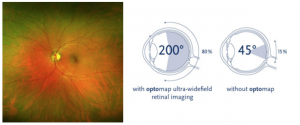“Do I need the scans?” Something we hear daily at our office because almost half of our patients have vision insurance. Most insurance plans don’t always cover, in its entirety, what we offer as a complete vision exam. Because of this, a question we hear a lot in our office at the beginning of each exam is, “Do I need the scans?” or “why do have I have to pay more for the scans?” and the short answer is Yes. But let’s explain why.
Scans #1: Optomap
Let’s first go over what “the scans” are. We have two additional pieces of equipment in our office that not all offices have. The first is the Optomap. The optomap ultra-widefield retinal image is a unique technology that captures more than 80% of your retina in one panoramic image while tra ditional imaging methods typically only show 15% of your retina at one time. You’ve probably heard about drops that dilate your eyes and how most people don’t like them. They dilate your pupils so the doctor can see in with a scope and manually look at your retina, 15% at a time. The drops don’t feel good and they last for hours inhibiting your ability to read clearly. They also lengthen your exam time while the drops take time to work. Therefore, the Optomap is reco
ditional imaging methods typically only show 15% of your retina at one time. You’ve probably heard about drops that dilate your eyes and how most people don’t like them. They dilate your pupils so the doctor can see in with a scope and manually look at your retina, 15% at a time. The drops don’t feel good and they last for hours inhibiting your ability to read clearly. They also lengthen your exam time while the drops take time to work. Therefore, the Optomap is reco
mmended. It doesn’t require dilation, it’s instantaneous and the doctor gets a much bigger picture into the health of your eye, blood vessel and optic nerve while aiding the in early detection and management of diseases of both your eye health and overall health.
Scan #2: Optovue OCT

The second piece of equipment that is included in “the scans” is called Optical Coherence Tomography or OCT for short. It’s a technique for obtaining sub-surface images of translucent or opaque materials at a resolution equivalent to a low-power microscope. It’s effectively an “optical ultrasound” imaging reflections from within tissue to provide cross-sectional images. All this to say, it is able to take a microscopic cross-sectional image of the layers of your retina. This helps doctors diagnose and treat glaucoma and other retinal diseases like age-related macular degeneration and diabetic eye disease and potentially catch diseases before they start. It is also strongly recommended by our Doctor.
You can see why this equipment is so important. It uses the modern-day technology to aid optometrists in making your complete eye exam easier, faster and more in depth. Some insurance companies haven’t caught up with the modern technology and don’t cover the cost of these tests, which is why it comes with additional co-pays.
Dr. Christensen doesn’t hesitate to recommend it to every patient she sees because she believes that this is a definitive, more in depth way to monitor your eye health and detect problems 7-8 years before she could otherwise! Give us a call if you’ve never had these scans done and make sure you include them in your next complete vision exam.
At Rancho Santa Fe Optometry we offer comprehensive eye examinations for all ages. With a focus on children’s vision and vision therapy, our doctors test for visual acuity, visual efficiency skills and visual information processing starting in early infancy. The practice also provides diagnosis, treatment and management of diseases that affect the human eye and visual system, including dry eye syndrome, diabetic retinopathy, cataracts, macular degeneration and keratoconus.



